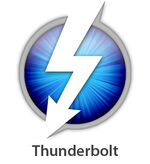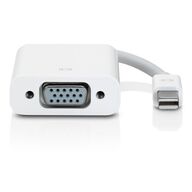
The official Apple version of the Thunderbolt logo.
Thunderbolt is an I/O technology developed by Intel in collaboration with Apple Inc. It first introduced by Apple in its 2011 line of MacBook Pros and became the official replacement for FireWire and was the standard above USB until USB4.
Versions[]

Thunderbolt 1 / 2
- Thunderbolt 1 can reach transfer rates of up to 10Gbps through an interface that looks like and is backwards compatible with Mini DisplayPort. Thunderbolt also can deliver Gigabit Ethernet through an adapter.
- Thunderbolt 2 uses the same Mini DisplayPort connector as Thunderbolt 1, but can reach transfer rates of up to 20Gbps.

Thunderbolt 3 / 4
- Thunderbolt 3 uses the USB-C form factor and can reach transfer rates of up to 40Gbps. USB4 uses the same form factor and is basically the same as a USB-C port that supports Thunderbolt 3 signals.
- Thunderbolt 4 uses the same USB-C form factor as Thunderbolt 3, but specifies a minimum bandwidth of 32Gbps for PCIe link, support for dual 4K displays, and protection against DMA attacks.[1][2]
Pinouts[]
Thunderbolt 1 and 2[]
| Pin | ID | Description |
|---|---|---|
| 01 | GND | Ground |
| 02 | HPD | Hot plug detect |
| 03 | HS0TX(P) | HighSpeed transmit 0 (positive) |
| 04 | HS0RX(P) | HighSpeed receive 0 (positive) |
| 05 | HS0TX(N) | HighSpeed transmit 0 (negative) |
| 06 | HS0RX(N) | HighSpeed receive 0 (negative) |
| 07 | GND | Ground |
| 08 | GND | Ground |
| 09 | LSR2P TX | LowSpeed transmit |
| 10 | GND | Ground (reserved) |
| 11 | LSP2R RX | LowSpeed receive |
| 12 | GND | Ground (reserved) |
| 13 | GND | Ground |
| 14 | GND | Ground |
| 15 | HS1TX(P) | HighSpeed transmit 1 (positive) |
| 16 | HS1RX(P) | HighSpeed receive 1 (positive) |
| 17 | HS1TX(N) | HighSpeed transmit 1 (negative) |
| 18 | HS1RX(N) | HighSpeed receive 1 (negative) |
| 19 | GND | Ground |
| 20 | DPPWR | Power |
Gallery[]
The Mini DisplayPort to VGA Adapter is backwards-compatible with Thunderbolt 1 and 2.
11 and 13-inch MacBook Airs with a Thunderbolt port
References[]
- ↑ Introducing Thunderbolt 4: Universal Cable Connectivity for Everyone, Intel. 2020-07-08.
- ↑ Intel Teases Thunderbolt 4, Light on Details. Retrieved on 16 May 2020.
External links[]
- Introducing Thunderbolt. at Apple (archived 2011-02-26)
- MacBook Pro: Thunderbolt (archived 2011-02-27)
- iMac: Thunderbolt (archived 2011-05-11)
- Adapters for the Thunderbolt 3 or USB-C port on your Mac or iPad Pro at Apple Support
- Thunderbolt (interface) at Wikipedia



